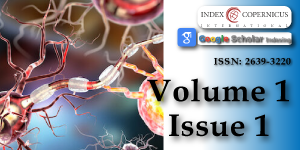Protective functions of AEURA in Cell Based Model of Stroke and Alzheimer disease
Main Article Content
Abstract
Stroke and neurodegenerative diseases including Alzheimer’s disease (AD) are responsible for a major proportion of mortalities in the elderly. We have previously investigated novel mechanism-based therapies of AEURA in cell culture models against viral infection and in glutamate excitotoxity. In our new studies, we propose that the homeopathic formula AEURA could serve as a potential therapeutic agent for stroke & for AD. In examining AEURA treatment of PC12 cells exposed to glutamate excitotoxicity, hypoxia /re-oxygenation injury and A-Beta toxicity. We demonstrated an increased survival rate in AEURA treated cells by comparison to control cells. In examining the therapeutic potential of AEURA in PC12 cells this homeopathic agent was found to be neuroprotective against either glutamate induced toxicity, hypoxia /re-oxygenation stress or cell stress resulting from viral infection (with either HSV-1 or rhinovirus). Our ongoing studies involve examining the neuroprotective potential AEURA in vivo using rodent models of stroke & AD.
Article Details
Copyright (c) 2017 Modi J, et al.

This work is licensed under a Creative Commons Attribution 4.0 International License.
Kwiatkowski T, Libman R, Tilley BC, Lewandowski C, Grotta JC, et al. The impact of imbalances in baseline stroke severity on outcome in the national institute of neurological disorders and stroke recombinant tissue plasminogen activator stroke study. Ann Emerg Med. 2005; 45: 377-384. Ref.: https://goo.gl/kKHTR2
Moreau F, Yang R, Nambiar V, Demchuk AM, Dunn JF. Near-infrared measurements of brain oxygenation in stroke. Neurophotonics. 2016; 3. Ref.: https://goo.gl/0J0H1h
Roffe C. Hypoxaemia and stroke. Rev Clin Gerontol. 2001; 11: 323-335. Ref.: https://goo.gl/O3j4P1
Dávalos A, Shuaib A, Wahlgren NG. Neurotransmitters and pathophysiology of stroke: evidence for the release of glutamate and other transmitters/mediators in animals and humans. J Stroke Cerebrovasc Dis. 2000; 9: 2-8. Ref.: https://goo.gl/RHWvve
Prentice H, Modi JP, Wu JY. Mechanisms of neuronal protection against excitotoxicity, endoplasmic reticulum stress, and mitochondrial dysfunction in stroke and neurodegenerative diseases. Oxid Med Cell Longev. 2015; 2015: 964518. Ref.: https://goo.gl/Io2Z5N
Alexandrova M, Bochev P, Markova V, Bechev B, Popova M. Dynamics of free radical processes in acute ischemic stroke: influence on neurological status and outcome. J Clin Neurosci. 2004; 11: 501-506. Ref.: https://goo.gl/oFEakI
Lipton P. Ischemic cell death in brain neurons. Physiol Rev. 1999; 79: 1431-1568. Ref.: https://goo.gl/CqKTVJ
Mohammad-Gharibani P, Modi J, Menzie J, Genova R, Ma Z. Mode of action of S-Methyl-N, N-Diethylthiocarbamate Sulfoxide (DETC-MeSO) as a novel therapy for stroke in a rat model. Mol Neurobiol. 2014; 50: 655-672. Ref.: https://goo.gl/DZXDLQ
Lyden P, Wahlgren NG. Mechanisms of action of neuroprotectants in stroke. J Stroke Cerebrovasc Dis. 2000; 9: 9-14. Ref.: https://goo.gl/fPWBGQ
Heron M. Deaths: leading causes for 2010. Natl Vital Stat Rep. 2013; 62: 1-96. Ref.: https://goo.gl/6NfRh2
Xu J, Kochanek KD, Murphy SL, Tejada-Vera B. Deaths: final data for 2007. Natl Vital Stat Rep. 2010; 58: 1-19. Ref.: https://goo.gl/0yKvUC
Heron M. Deaths: leading causes for 2010. Natl Vital Stat Rep. 2013; 20: 62: 1-96. Ref.: https://goo.gl/FKK7q6
Hebert LE, Weuve J, Scherr PA, Evans DA. Alzheimer disease in the United States (2010-2050) estimated using the 2010 census. Neurology. 2013; 80: 1778-1783. Ref.: https://goo.gl/ua9lDV
Chafekar SM, Baas F, Scheper W. Oligomer-specific Aβ toxicity in cell models is mediated by selective uptake. Biochim Biophys Acta-Mol Basis Dis. 2008; 1782: 523-531. Ref.: https://goo.gl/pQg5of
Products-AEURA [WWW Document], 2008. URL http://aeura.co/products/ (accessed 4.21.17).
Prentice H, Modi J, Menzie J, Chou H, Weiss A, et al. SciTz neurology and neurosciences neuroprotective mechanisms of action of DETC-Meso, GCSF, sulindac, taurine and AEURA 2016; 1.
Pan C, Prentice H, Price AL, Wu JY. Beneficial effect of taurine on hypoxia- and glutamate-induced endoplasmic reticulum stress pathways in primary neuronal culture. Amino Acids. 2012; 43: 845-855. Ref.: https://goo.gl/hr3im1
Ma S, Liu H, Jiao H, Wang L, Chen L. Neuroprotective effect of ginkgolide K on glutamate-induced cytotoxicity in PC 12 cells via inhibition of ROS generation and Ca2+ influx. Neurotoxicology. 2012; 33: 59-69. Ref.: https://goo.gl/gfLfWL
Kim JY, Jeong HY, Lee HK, Kim S, Hwang BY. Neuroprotection of the leaf and stem of Vitis amurensis and their active compounds against ischemic brain damage in rats and excitotoxicity in cultured neurons. Phytomedicine. 2012; 19: 150-159. Ref.: https://goo.gl/sAbGZv
Chen J, Chua KW, Chua CC, Yu H, Pei A. Antioxidant activity of 7,8-dihydroxyflavone provides neuroprotection against glutamate-induced toxicity. Neurosci Lett. 2011; 499: 181-185. Ref.: https://goo.gl/a4M8rg
Hirata Y, Yamamoto H, Atta MS, Mahmoud S, Oh-hashi K. Chloroquine inhibits glutamate-induced death of a neuronal cell line by reducing reactive oxygen species through sigma-1 receptor. J Neurochem. 2011; 119: 839-847. Ref.: https://goo.gl/NyE2pY
Kanki R, Nakamizo T, Yamashita H, Kihara T, Sawada H. Effects of mitochondrial dysfunction on glutamate receptor-mediated neurotoxicity in cultured rat spinal motor neurons. Brain Res. 2004; 1015; 73-81. Ref.: https://goo.gl/SozTMn
Ferreira A, Sinjoanu RC, Nicholson A, Kleinschmidt S. Aβ toxicity in primary cultured neurons. 2010; 141-153. Ref.: https://goo.gl/zXyDCB

